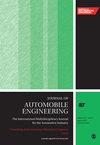Controllable region analysis of active front steering and differential braking system stability control characterized by additional yaw moment
IF 1.5
4区 工程技术
Q3 ENGINEERING, MECHANICAL
Proceedings of the Institution of Mechanical Engineers Part D-Journal of Automobile Engineering
Pub Date : 2024-07-23
DOI:10.1177/09544070241260469
引用次数: 0
Abstract
Active Front Steering (AFS) and Differential Braking System (DBS) are commonly used execution systems for vehicle anti-rollover or handling stability control. They regulate the vehicle’s yaw moment by adjusting the lateral tire force and longitudinal tire force, respectively. However, these two systems differ in terms of control capabilities and regulatory sensitivities. In emergency conditions, it becomes crucial to allocate and coordinate the tasks for the execution systems according to their yaw moment control capability and adjustment sensitivity. This paper proposes a method for calculating the controllable region represented by the additional yaw moment. This method allows for the computation of the control capability of AFS and DBS based on the current state. Additionally, the influence of different vehicle states on the controllable regions of the two execution systems is analyzed. Building upon this analysis, the yaw moment adjustment sensitivities of AFS and DBS systems under the current state are further investigated. Finally, a task coordinated strategy between AFS and DBS is developed based on the analysis of controllable regions and sensitivities of different execution systems. Simulink simulations are conducted on yaw stability and roll stability conditions to comprehensively analyze the working process of the proposed task coordination strategy.以附加偏航力矩为特征的主动前转向和差速制动系统稳定性控制的可控区域分析
主动前转向系统(AFS)和差速制动系统(DBS)是车辆防侧翻或操纵稳定性控制常用的执行系统。它们分别通过调整横向轮胎力和纵向轮胎力来调节车辆的偏航力矩。然而,这两种系统在控制能力和调节灵敏度方面存在差异。在紧急情况下,根据偏航力矩控制能力和调节灵敏度来分配和协调执行系统的任务变得至关重要。本文提出了一种计算额外偏航力矩所代表的可控区域的方法。该方法可根据当前状态计算 AFS 和 DBS 的控制能力。此外,本文还分析了不同车辆状态对两种执行系统可控区域的影响。在此分析基础上,进一步研究了 AFS 和 DBS 系统在当前状态下的偏航力矩调整敏感性。最后,根据对不同执行系统的可控区域和敏感性的分析,制定了 AFS 和 DBS 之间的任务协调策略。在偏航稳定和滚转稳定条件下进行了 Simulink 仿真,以全面分析所提出的任务协调策略的工作过程。
本文章由计算机程序翻译,如有差异,请以英文原文为准。
求助全文
约1分钟内获得全文
求助全文
来源期刊

CiteScore
4.40
自引率
17.60%
发文量
263
审稿时长
3.5 months
期刊介绍:
The Journal of Automobile Engineering is an established, high quality multi-disciplinary journal which publishes the very best peer-reviewed science and engineering in the field.
 求助内容:
求助内容: 应助结果提醒方式:
应助结果提醒方式:


